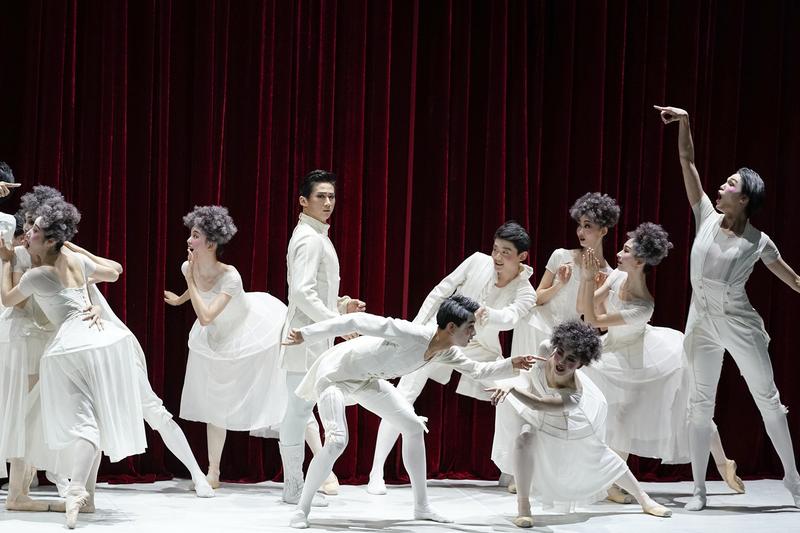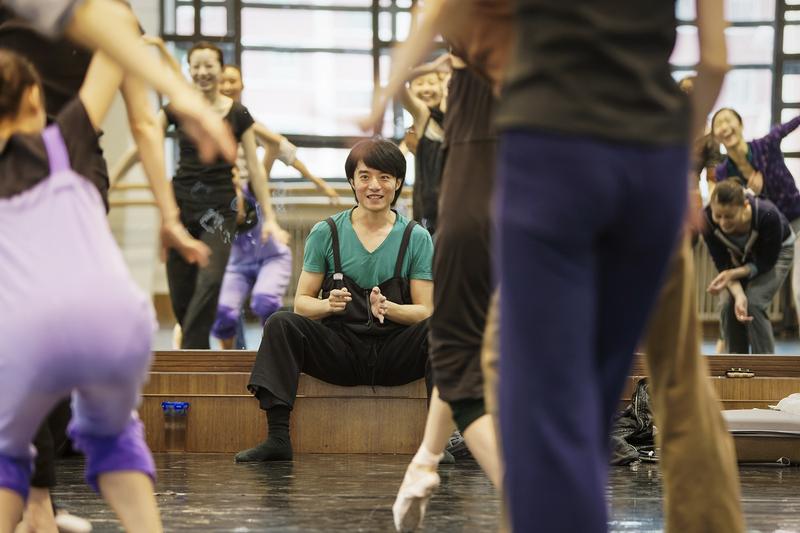Choreographer from the National Ballet of China will be showcased as part of the company's "20-year" series, Chen Nan reports.
 Choreographer Fei Bo's piece Hamlet, based on William Shakespeare's classic tragedy, will be staged on Tuesday and Wednesday in Beijing as part of Fei's 20th anniversary performances. (PHOTO PROVIDED TO CHINA DAILY)
Choreographer Fei Bo's piece Hamlet, based on William Shakespeare's classic tragedy, will be staged on Tuesday and Wednesday in Beijing as part of Fei's 20th anniversary performances. (PHOTO PROVIDED TO CHINA DAILY)
Choreographer Fei Bo will celebrate his 20th anniversary in the job with a selection of his creations being performed at Tianqiao Theater in Beijing on Tuesday and Wednesday.
"For dancers, 20 years encapsulates the best days of their careers, but for choreographers, 20 years is just a beginning," says Fei, who is in his early 40s and has worked as a choreographer with the National Ballet of China since 2002..
I enjoyed the freedom that I felt during the process of choreographing the piece. I really loved sitting in the rehearsal room, watching the dancers, and the ideas just came out naturally.
Fei Bo, choreographer
"It may be a bit early to celebrate, but I want to take the opportunity to inspire the company's younger choreographers."
During the past 20 years, Fei has choreographed about 60 dance works, of which he has selected 10 to be staged by the National Ballet of China's dancers. It is part of the dance company's "20 years" series that celebrates dancers and choreographers, who have made outstanding contributions to its development.
Leading ballet dancers Zhu Yan, Zhang Jian and Wang Qimin have celebrated their 20th anniversary. Fei will be the first choreographer of the company to mark the milestone.
Sitting in a hutong coffee shop, Fei enjoys the morning sunshine while looking at the view outside the window. Though he is humble about the 20th anniversary celebration, he is excited about reviewing some of his works, which will be staged together for the first time. These works, as he describes, were created at some key moments of his career and mean a lot to him personally, mirroring his artistic evolution.
One of the 10 dance works is The Peony Pavilion, which premiered in Beijing in 2008. Adapted from the classic Kunqu Opera piece written by Tang Xianzu of the Ming Dynasty (1368-1644), with the same title, it was Fei's first solo, full-length ballet choreography, while working with veteran theater director Li Liuyi and celebrated composer Guo Wenjing. Fei was 28 years old at the time. Parts of The Peony Pavilion will be staged during this week's performances.
 Choreographer Fei Bo sits in a rehearsal room of the National Ballet of China and works with the dancers. (PHOTO PROVIDED TO CHINA DAILY)
Choreographer Fei Bo sits in a rehearsal room of the National Ballet of China and works with the dancers. (PHOTO PROVIDED TO CHINA DAILY)
The story follows Du Liniang, the young daughter of a high-ranking official, who meets the young scholar Liu Mengmei in a dream. Du awakens and pines for her phantasmal lover, then dies, leaving behind a self-portrait. Liu happens to be a real person, who through sheer accident, ends up staying in Du's town. He discovers her painting, and falls in love with her. Then the underworld judge, moved by their undying love, sends Du back to the mortal world, where the lovers finally unite.
"I was very nervous about working with those artists, but I was very relaxed about my choreography because I had lots of ideas about this classic work. In the story, love, desire, suffering, departure and death happen between the time Du closes her eyes and later awakes. It is very beautiful," says Fei, adding that, after the premiere of the dance production, he had dinner with the dancers and creative team.
"I fainted during the dinner. When I woke up, I was in a hospital. Maybe I was exhausted or maybe I was too excited."
For the week's performances, he has also selected his choreographed piece Confucius 2012. He created two images of Confucius onstage that year, one worshipped by people for over 2,000 years, and the other of Confucius himself. Fei says the dance piece is his observation of contemporary people's studies of the ancient Chinese philosopher.
"It is an interesting piece that took me a long time to create, as I thought deeply about Confucius," he says.
In the second half of this week's show, audiences will get a glimpse of Fei's take on Shakespeare's Hamlet, in which he presents the complex state of Hamlet's mind and attitude toward himself. By interpreting Hamlet, Fei tells the dramatic story, full of human emotions, through ballet.
Hamlet was first staged during the National Ballet of China's annual workshop, which was launched in 2010 and aims to inspire and nurture young dancers and choreographers.
"The process is tough. Like Hamlet, I faced many contradictions," Fei says.
His process of creating a dance was full of challenges earlier. Besides dealing with his own artistic pursuit, Fei also had to handle different feedback from the audience, some full of praise while others more negative.
 Fei (left) helps the dancers to interpret and develop ideas during the rehearsal of his piece Light of Heart, which premiered in 2017. (PHOTO PROVIDED TO CHINA DAILY)
Fei (left) helps the dancers to interpret and develop ideas during the rehearsal of his piece Light of Heart, which premiered in 2017. (PHOTO PROVIDED TO CHINA DAILY)
When his dance piece, Dunhuang (Light of Heart), premiered in 2017, an audience member made a negative comment about it, saying the work "destroyed the beauty of ballet".
The ballet piece told a story inspired by the Mogao Caves in Dunhuang, Northwest China's Gansu province, and portrays an early batch of experts who devoted their lifetime unearthing sculptures, preserving the artworks and restoring the caves. During the upcoming performance, an excerpt will be displayed.
"It was not the first time that I was challenged by an audience's negative feedback. Art is very personal and subjective, so it's normal to have different reviews," says Fei, adding that in 2013, when his choreographed piece Bolero was staged, an audience member, apparently disliking Fei's choreography, left the theater in the middle of the performance.
"But I like the piece very much, and even today, I think it's one of my best works," Fei says.
Born in Chaohu, East China's Anhui province, Fei grew up in a family of performers and musicians of the traditional Luju Opera and has always been familiar with the stage. His mother died when he was 10 years old and his father never pushed him to pursue a career in the art form.
As a child, Fei showed a passion for dancing, and in 1992, he studied traditional Chinese dance at a local art school. He did his first choreography for the school's graduation show and he was the only one in his class who did it.
"I enjoyed the freedom that I felt during the process of choreographing the piece. I really loved sitting in the rehearsal room, watching the dancers, and the ideas just came out naturally," he says.
In 1998, Fei joined the Beijing Dance Academy, a leading dancing school in China, where he was introduced to contemporary dance. After graduation, he joined the National Ballet of China, since he was drawn to the beauty of the dance form.
As a young choreographer, Fei participated in many international ballet productions, such as Raise the Red Lantern, directed by Zhang Yimou in 2001, and Fei's choreography piece, Memory, won him the best choreographer prize at the Helsinki International Ballet Competition in 2005.
"Original work is the key to the development of Chinese ballet. Fei Bo has been testing his choreography's ingenuity and has seen the stages of the world. Twenty years marks a fresh start for him," says Feng Ying, president of the National Ballet of China, adding that continuing to develop classical ballet and encouraging young choreographers to create new works have always been the two core missions of the company.
In September, Fei will visit Helsinki to attend the world premiere of Triple Bill, a series commissioned by the Finnish National Ballet. Triple Bill features contemporary dance choreographies by three of today's most talked about choreographers from three continents. The other two works set to be featured are Dust by British choreographer Akram Kham and Heatscape by US choreographer Justin Peck.
Fei's Earthborn is inspired by indigenous people and their close connections to nature and their native lands. He doesn't draw lines between different cultures. Instead, he sees dance as a fusion that can incorporate a wide variety of cultural elements.
Contact the writer at chennan@chinadaily.com.cn


